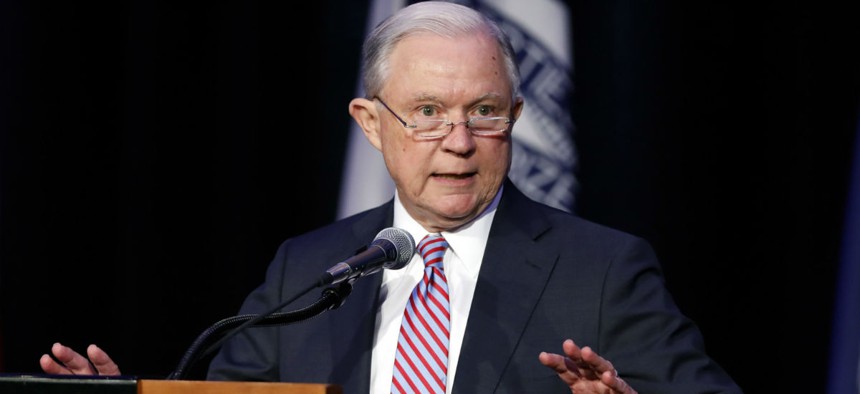
Attorney General Jeff Sessions has streamlined hiring under deadlines announced last year. Charlie Neibergall/AP
Justice Department Touts New Immigration Judges, Quicker Hiring
Twenty-three judges were sworn in Aug. 10 and recruitment time was cut in half.
As the Justice Department’s immigration review office struggles with children coming across the border, it is hailing progress in reducing long-standing delays in hiring more immigration judges.
On Aug. 10, 23 new judges were invested by the department’s Executive Office for Immigration Review, the largest class since at least 2010, the department announced. That represents a cut in average hiring time by more than 50 percent, which the department said was the result of Attorney General Jeff Sessions' effort at streamlining hiring under deadlines announced last year.
Some of the new immigration judges were hired in about 266 days, down from an average of 742 days a year ago, Justice stated. A 2017 Government Accountability Office report said hiring immigration judges was taking about two years, and that the review office lacked a clear hiring strategy.
The new batch of judges—who took the oath in Justice’s Great Hall—boosts the total number of immigration judges to 351, with 82 of them having been sworn in during the Trump administration as it implements its controversial “zero tolerance” border enforcement policy that has left children separated from parents. Justice expects another 75 judges this fall.
“Hiring more immigration judges and reducing the time it takes to hire a judge are two key elements of reducing the pending caseload of immigration court cases,” Sessions said. Immigration review Director James McHenry "should be commended for making tremendous progress on both fronts since he became acting director in May 2017. Under his leadership, we are making great strides toward having an immigration court system that serves the national interest.”
This Thursday, McHenry told a Senate Homeland Security and Governmental Affairs Subcommittee hearing on unaccompanied children crossing the southern border that there are 80,000 related cases currently before his office, about 11 percent of the overall pending caseload. “Over 70 percent of those cases have been pending for over one year,” he added. In fiscal 2018 to date, only 9,600 unaccompanied children immigration cases have been completed in immigration court, compared with 135,000 other types of immigration cases that have been completed.
Judge Dana Leigh Marks, speaking for the National Association of Immigration Judges, told Government Executive that her group is “thrilled that progress is being made” in hiring but that the immigration courts are still “woefully understaffed.”
The current budget authorized 384 judges, so the new total of 351, which includes 20 supervisors, still leaves the judges’ corps under its planned allocation. “The proposed budget for next year would augment our corps by another 75-100, which potentially brings the court up to 459-484 judges,” she added.
But the case backlog is currently 733,000 cases, Marks said. Her group recommends that each judge be assigned a docket on average of 700 cases across the system, which would require a total of 1,000 judges, she said.
Immigration law is constantly compared to tax law in its complexity, she added. “We do death penalty cases in a traffic court setting," she said. "That’s the stakes for asylum cases.”
In June, many immigration judges expressed shock after President Trump characterized them as vulnerable to corruption and superfluous to the immigration system.







